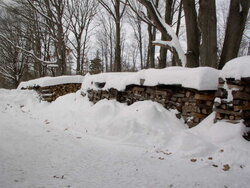Backwoods Savage
Minister of Fire
Sorry, TimJ, I just don't believe it. Everything else in the world gets soggy when rained on and I don't think wood is a magical exception. The time that you're waiting for the sun and wind to bring your wood back to its before-the-rain condition is time when no drying is happening. Why not just cover and make steady progress rather than having every rain storm set you back?
NJ is a whole different ball game than Indiana. Think about quads up in MN (haven't heard from him lately). He burns all oak and never covers his wood.
It had been a long, long time since I've left any wood uncovered until burned. I have some now that has never been covered. Probably won't get to it for a couple years yet but might try some next year just for kicks. Normally we split and stack in the spring and then top cover before the snow flies in November or December.
Top covered with galvanized roofing.




